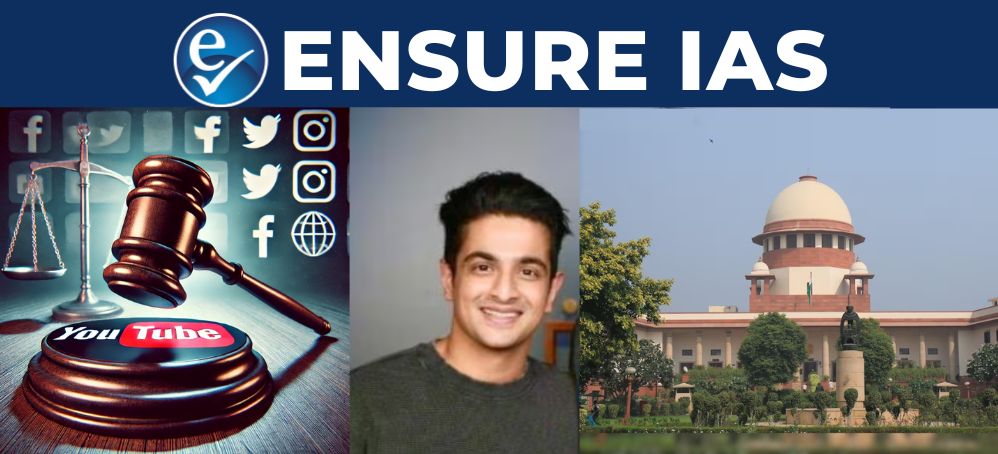- Courses
- GS Full Course 1 Year
- GS Full Course 2 Year
- GS Full Course 3 Year
- GS Full Course Till Selection
- Essay Target – 150+ Marks
- Online Program
- GS Recorded Course
- NCERT (Recorded 500+ Hours)
- Polity Recorded Course
- Geography Recorded Course
- Economy Recorded Course
- AMAC Recorded Course
- Modern India, Post Independence & World History
- Environment Recoded Course
- Governance Recoded Course
- Science & Tech. Recoded Course
- International Relations and Internal Security Recorded Course
- Disaster Management Module Course
- Ethics Recoded Course
- Current Affairs Recoded Course
- CSAT
- 5 LAYERED ARJUNA Mentorship
- Public Administration Optional
- ABOUT US
- OUR TOPPERS
- TEST SERIES
- FREE STUDY MATERIAL
- VIDEOS
- CONTACT US
The YouTube Obscenity Case: Freedom vs. Decency
The YouTube Obscenity Case: Freedom vs. Decency
24-02-2025

- In February 2025, a controversial remark made during an episode of a popular YouTube show caused a lot of anger in the public.
- The comments were considered offensive.
- As a result, FIRs were filed in two states: Maharashtra and Assam.
- The show, initially meant for a small audience, went viral, resulting in public backlash and legal action.
- And then the Supreme Court intervened, granting protection from arrest, while also criticizing the comments made.
- The National Commission for Women also issued summons to individuals involved, and the legal proceedings continue.
- The incident has brought a debate about the application of obscenity laws in digital content.
What is Obscenity?
Obscenity is anything that strongly offends what most people in a society consider morally acceptable, especially when it involves sex or bodily functions. It's hard to define perfectly because what's offensive changes from person to person and place to place.
Laws Governing Obscenity in Online Content:
1. Bharatiya Nyaya Sanhita, 2023 (BNS):
-
- Section 294 of the BNS punishes the sale or display of obscene material, which can include books, images, or online content.
- The law defines obscene content as being overly sexual or crude, which can harm or negatively influence people who see or hear it.
- Penalties: 1st-time offenders can face up to 2 years of prison and a Rs. 5,000 fine.
2. Section 67 of the IT Act, 2000:
-
- This section covers the use of the internet to publish or share obscene material.
- Penalties for violating this law include up to 3 years in prison and a Rs. 5 lakh fine for 1st-time offenders.
Evolution of Obscenity Laws: From Hicklin Test to Roth Test
1. Hicklin Test (1868):
-
- The Hicklin Test was developed in the UK in the 19th century.
- It defined obscenity as content that could corrupt or influence the minds of vulnerable people, even if only part of the material was inappropriate.
- In India, this test was used in the Ranjit D. Udeshi case (1964) to ban the book Lady Chatterley’s Lover, which was seen as inappropriate for public reading.
2. Shift from Hicklin Test:
-
- In 1959, the UK modified its approach with the Obscene Publications Act, requiring material to be evaluated as a whole, not just individual parts, before deciding if it was obscene.
- Similarly, in 1957, the US shifted its standard in the Roth v. United States case, using the “average person” standard based on modern community standards.
3. Indian Shift:
-
- In Aveek Sarkar v. State of West Bengal (2014), the Indian Supreme Court adopted the community standards test, considering societal values and how material impacts people as a whole.
- It emphasized that what was once considered obscene might not be seen as offensive today.
- Key takeaway: Obscenity is now judged based on current societal norms and evolving values.
Freedom of Expression and Obscenity
- Article 19 of the Indian Constitution guarantees the right to freedom of speech and expression.
- However, this right is not unlimited and can be restricted on certain grounds, including decency and morality.
- Balancing free speech with public decency means content can be penalized if it violates societal norms of decency.
Recent Controversies on Obscenity
1. Urfi Javed (2023):
-
- The actor was criticized for wearing inappropriate clothing in public.
- Some political figures asked for legal action, citing obscenity laws.
2. Ranveer Singh (2022):
-
- The actor faced police action after sharing nude photographs on social media for a magazine cover.
- He was booked under Sections 292, 293, 509 of the IPC and Section 67A of the IT Act.
About the National Commission for Women (NCW)
|
|
Also Read |
|
| FREE NIOS Books | |




